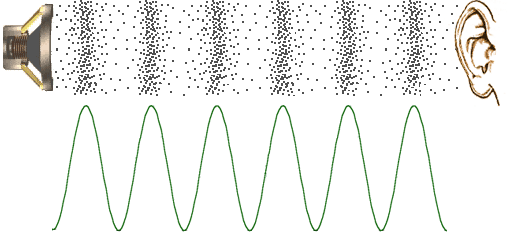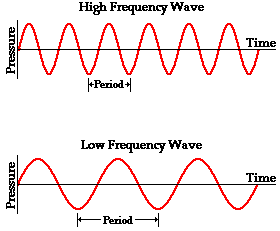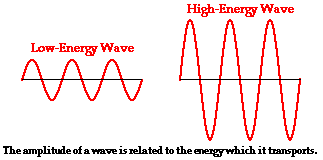Sound - Part 1
What is sound and how does it work? This two part visit will cover what sound is and how it travels. We'll do some activities to create sound and test how it travels through different mediums. We'll also make our own instruments and learn about pitch in both wind and string instruments.
What is sound?
Sound is a vibrational energy that travels via pressure wave. But what is vibrational energy? And what is a pressure wave??
The sounds you are used to in everyday life are caused by air vibrating. To make anything move (or vibrate) requires energy. So we can think of sound as a type of energy made by vibrations. Sound energy travels through the air by a pressure wave, which pushes the air molecules back and forth so that they oscillate - or vibrate. The sound travels through the air from the source (your clapping hands or the slamming door or the radio) to your ear.

The speaker vibrates, which casues the air near it to vibrate. This pushes forward a series of compressions (high pressure) and rarefactions (low pressure) that move through the air until they reach your ear. Even in your ear the sound energy causes your ear drum to oscillate back and forward. These vibrations produce lectrical signals transmitted through nerves to your brain where they are interpretted and sound! (Credit: Media College.Com)
What is a wave?
A wave is a backward and forward (or up and down) motion of something. So a wave oscillations. There are two main types of wave: transverse waves, like ripples on a pond and plucking a guitar stringi; and longitudinal waves, like through a slinky. Sound travels by longitudinal waves.

Transverse wave (like water ripples). (Credit: Dan Russell, Penn State)

Longitudinal wave (how sound travels). (Credit: Dan Russell, Penn State)
Look carefully at just one black dot in both waves. Note that it oscillates up and down in the transverse wave and it oscillates side to side in the longitudinal wave. Now watch the entire wave. Note that overall it appears to be moving in some direction. The wave is carry information in one direction, but each particle is just oscilate on the spot.
Activity 1 : Chinese whipsers. Have kids sit on the floor. Wisper something to the nearest kid and have them send the whipser on to the next persion. Continue for 5 or 10 people. Have the last person annouce to the class what the message was. Information was passed through a wave of whipsers.
Activity 2: Get the kids to stand in single file about an arm length apart. Have a message whispers down the line. This is the same way a sound wave carries information.
What does sound travel through?
As well as air, sound travels through water and even solids! Sound actually travels fasted though water than through air (about 4 times fasters), and it travels even faster through solids (about 15 times faster in steel than in air). The molecules in water are closer together than in air, and the atmons in solids are even more closely packed. This means the vibrations or osciallations of sound doesn't need to work so hard before they collide with their neighbouring molecules or atoms. This helps sound travel faster.
Sound travels faster in the steel tracks than thorugh the air. (Credit: NDT Resource Center.)
Activity 3: Have the kids stand in two stright lines just half an arm legnth apart in each row. (They should stand with their arms bent but touching the shoulder of the person in front of them.) Timing the two groups, have them (gently!!) bump the person behind them and pass the bump backwards. Next have the kids in each row stand more than an arms length apart. Again time them as they pass a bump down the line. Finally have the kids stand two giant steps apart for the person next to them. Time them again as they pass the bump down the line. But now the bumped person is not allowed to bump the person behind them until the first kids is back in their original spot. Which was fastest? When the kids were all bunched up or when the kids were all streched far apart? This is a bit like how long it takes sound to travel through a solid (atoms are all bunched up), through a liquid (molecular are close but not as close as in a solid) and a gas (the atoms are quite far apart from each other).
How do we hear sound?
The human ear can "feel" waves that vibrate in a certain frequency range. If air molecules are vibrating between about 20 times every second (20 Hz) and 20,000 times every second (20,000 Hz) we can hear the sound. At 20 Hz, the sound we would hear is a very deep, low, rumbling noise. At 20,000 Hz, the sound we would hear is a very high pitched, squealing sort of noise.

High frequency, high pitched sound (top) and low frequency, deep rumbling sound (bottom). (Credit: The Physics Classroom)
As well as the frequency of the wave (how fast it oscillates) determining its pitch, the amplitude of the wave (how big each oscillation is) deterines its loudness.
The more pressure or force that the sound wave 'pushes' on the air molecules, the larger the amplitude of the wave and the lounder the sound will be and the farther the sound wave can travel. (Which is why we can hear loud sounds in the next room, but we cannot hear quiet sounds from the next room.) The intensity or volume of sound is measured in decibels. Humans can hear sounds beteen about zero and 100 decibels.
(The amplitude of the wave determines its energy. Higher amplitude vibrations have more energy and the resulting sound will have a louder sound.)

Low energy, quiet sound (left) and high energy, loud sound (right) (Credit: The Physics CLassroom)
Last updated: Thursday, 03-May-2012 23:00:34 AEST
Back to Sarah's SiS page




